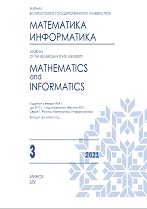|
|
Journal of the Belarusian State University. Mathematics and Informatics, 2017, Volume 1, Pages 47–52
(Mi bgumi167)
|
 |
|
 |
This article is cited in 1 scientific paper (total in 1 paper)
Mechanics of deformable solids
Solution of the axismmetric plane thermoelasticity problem for a polar-orthotropic disc of variable thickness in the rotating thermal field by Volterra integral equation of the second kind
V. V. Korolevicha, D. G. Medvedevb
a Branch office National Pedagogical University M. Dragomanov, Jaselska street, 266/10, 16000, Praha, Czech Republic
b Belarusian State University, Nezavisimosti avenue, 4, 220030, Minsk, Republic of Belarus
Abstract:
With the help of linear Volterra integral equation of the second kind the solution of the axisymmetric plane thermoelasticity problem for a polar-orthotropic disk of variable thickness in the rotating thermal field is generally given. It is assumed that the temperature field in the disk is known and it is axisymmetric. The elastic constants – Young's modulus and shear modulus – are linearly temperature dependent, and Poisson's coefficient are considered to be constant. With the stress function axisymmetric plane thermoelasticity problem is reduced to solving the differential equation of the second kind with variable coefficients. Constant efforts are set on the disc contours. The resulting differential equation is reduced to a linear integral Volterra equation of the second kind. The general solution of the integral equation is written
down the resolvent is used. The conditions under which the integral equation has a unique continuous solution are given. To calculate the solid drives the disk with a small central hole the radius of which is less than $\frac{1}{20}$ of the radius of the outer contour and the implementation of the condition that the radial and tangential stresses in the domestic circuit is implemented. Calculation formulas are given for the component of the radial, tangential stress and radial displacement.
Keywords:
polar-orthotropic disc; inhomogeneous thermal field; temperature; ratio thermoelasticity; differential and integral equations; resolvent; radial and tangential stress components; radial displacement.
Received: 12.05.2016
Citation:
V. V. Korolevich, D. G. Medvedev, “Solution of the axismmetric plane thermoelasticity problem for a polar-orthotropic disc of variable thickness in the rotating thermal field by Volterra integral equation of the second kind”, Journal of the Belarusian State University. Mathematics and Informatics, 1 (2017), 47–52
Linking options:
https://www.mathnet.ru/eng/bgumi167 https://www.mathnet.ru/eng/bgumi/v1/p47
|

| Statistics & downloads: |
| Abstract page: | 65 | | Full-text PDF : | 18 | | References: | 26 |
|




 Contact us:
Contact us: Terms of Use
Terms of Use
 Registration to the website
Registration to the website Logotypes
Logotypes








 Citation in format
Citation in format 
